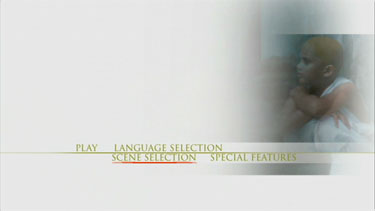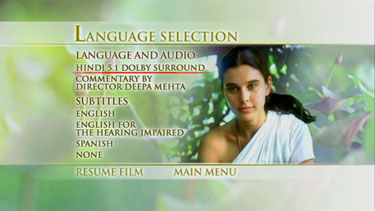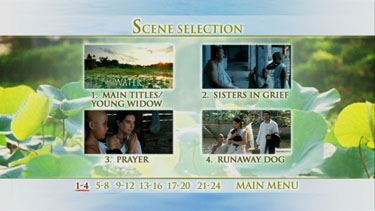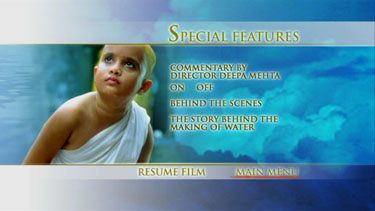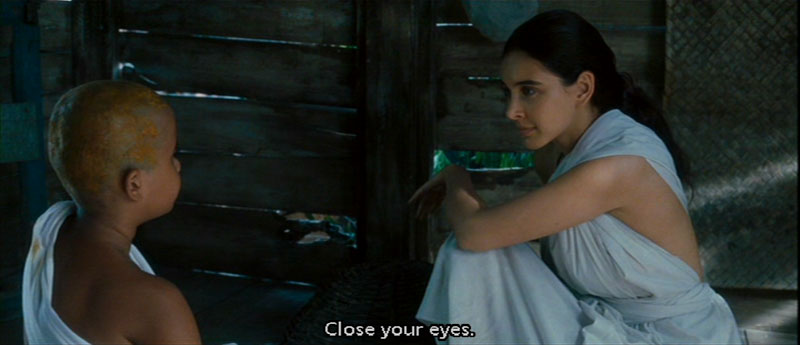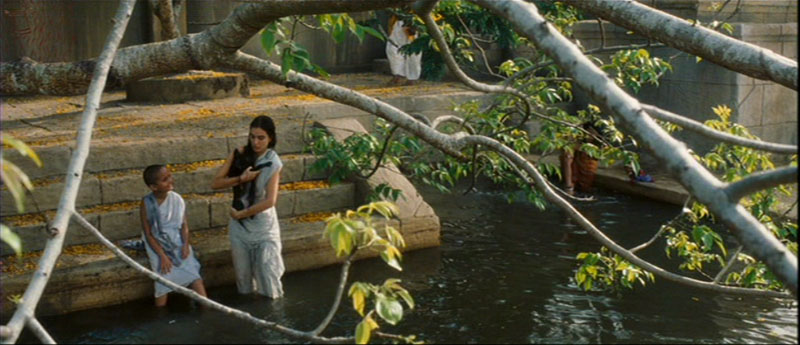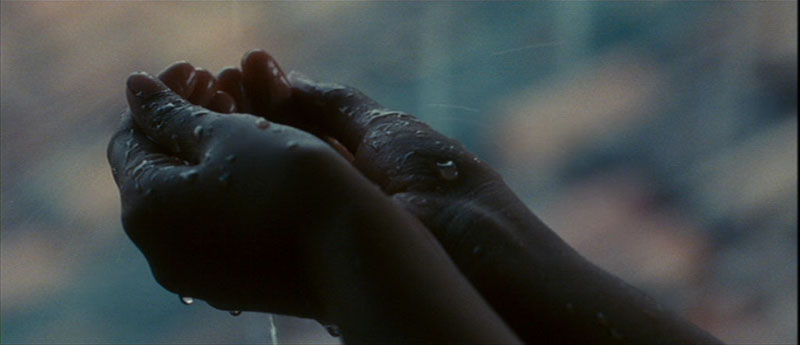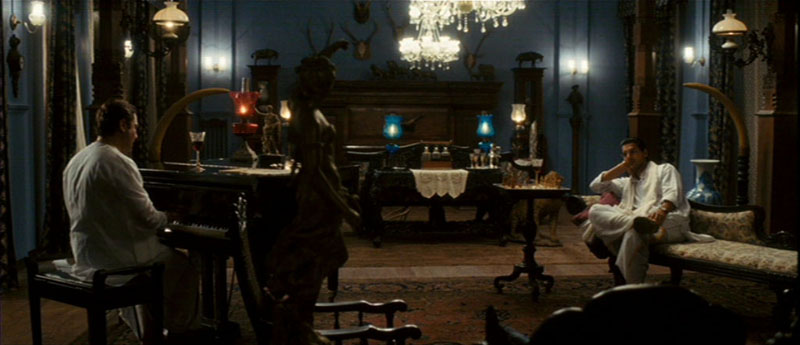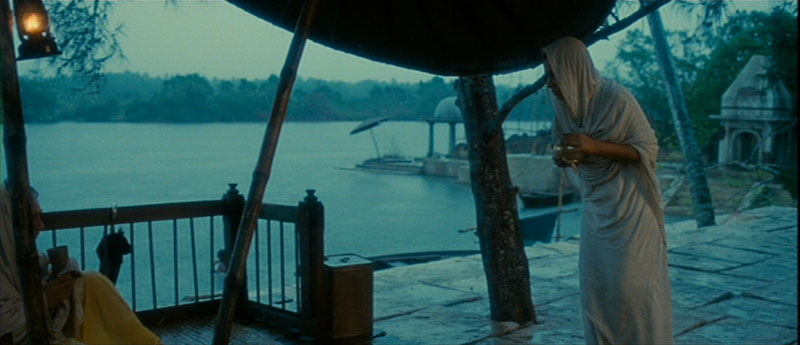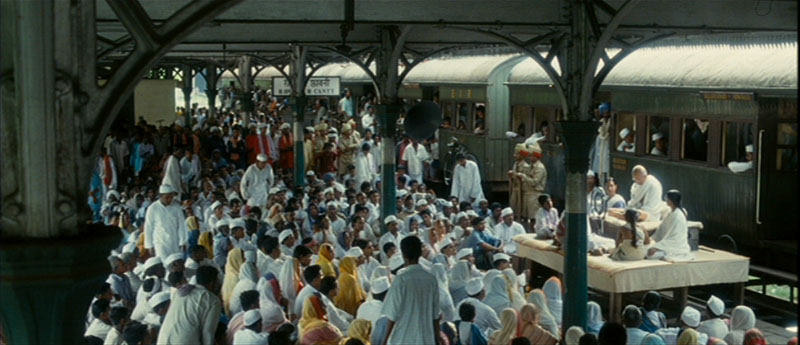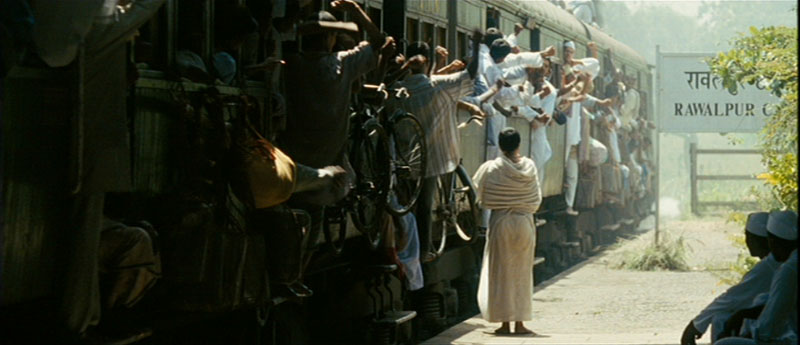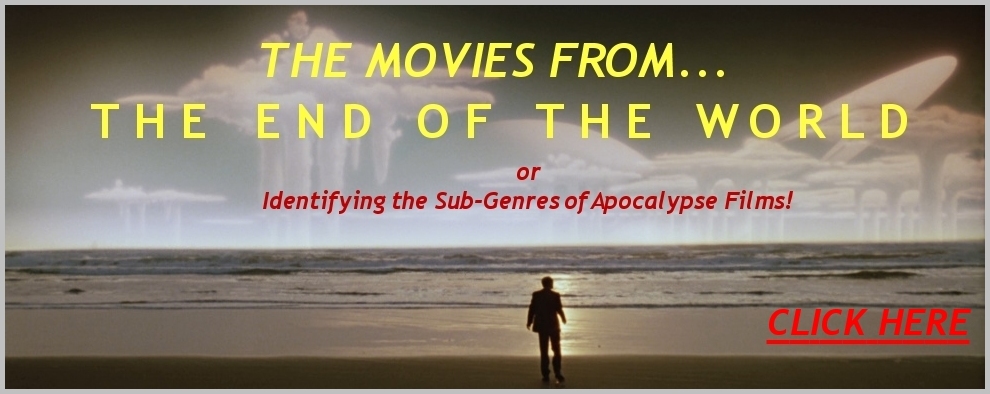![]()
![]()

![]()
![]()
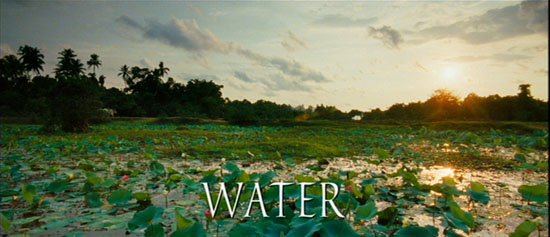
(aka "River Moon (Canada)" )
directed by Deepa Mehta
Sri Lanka 2005
I know little more than three things about
Indian cinema: (1) I’m aware of Satyajit Ray’s celebrated contributions to
film (“Pather Panchali,” 1955) and his co-founding of the Calcutta film
society; (2) I’ve heard of actor John Abraham (“Body,” 2003) and actress
Lisa Ray’s (“Bollywood/Hollywood,” 2002) reputations in Bollywood as
potential crossover stars; (3) and lastly, I’ve intently followed the
completion of Deepa Mehta’s Elemental Trilogy, which consists of “Fire”
(1996), Earth (1998), and the recently released “Water” (2006).
Almost immediately, you’ll probably notice the inconsistent gaps between the
release of Mehta’s films; particularly obvious is the eight years between
her second and third instalments to the trilogy. The reason behind the
delay is the formation of extremist groups consisting of Hindu
fundamentalists who were concerned for the potential negative implications
that could branch from the release of “Water.” Fearing that the film may
negatively convey their religion, these extremist groups immediately mounted
a protest against the film that included verbal death threats against Mehta,
the destruction of carefully designed sets, and the corruption of government
support. Unfortunately, these attacks were based largely on the controversy
that stemmed from Mehta’s previous films “Fire” and “Earth,” and a doctored
script that surfaced upon announcement of the film’s production. Mehta
attempted to clarify that her film would not directly attack present Hindu
traditions, but her efforts hardly eased the bitter and relentless
harassment.
The original production of “Water” began in India in 2000 and due to the
aforementioned issues was postponed for several years. Mehta would move on
to other projects (“Bollywood/Hollywood” and “The Republic of Love,” 2003),
but always maintained her intent to finish her trilogy. In light of the
controversy, Mehta decided to relocate the shooting to Sri Lanka. But, to
begin production again, Mehta was forced to re-secure a sufficient budget
and, in light of the time that had past, recast a considerable portion of
the characters. Most notably, in the time since her first attempt at the
film, Mehta encountered the work of actor John Abraham who she thought might
fit the leading male role in her film. She also worked closely with actress
Lisa Ray in “Bollywood/Hollywood” and developed a respect for Ray’s humanist
interests. Abraham and Ray were eventually cast in “Water” and the film’s
seemingly unfortunate past was in many ways a blessing for the film’s
development.
Mehta’s film concerns an issue that has long been present in India--the
mistreatment of Hindu widows. Set in 1938 against British colonialism and
Gandhi’s increasing influence over India, the film follows a series of
widows at an ashram located amidst poverty and changing streams of thought.
Unfortunately for the widows, the rethinking of traditional customs has yet
to affect their way of life. By Hindu law, when a married man passes on, a
portion of his wife dies with him. Effectively, widows must face one of
three consequences: they must (1) accept the fate of their husband and
perish by his side during his funeral; (2) marry his younger brother
(provided that he has one); or (3) assume banishment to an ashram for the
remainder of their life. Once placed in an ashram, the widows are treated
with hostility by the majority of society and seen as little more than bad
luck.
The film centers on how widows of different ages, maturity, backgrounds, and
personalities deal with their hopelessly limited fate at a single ashram.
Chuyia (Sarala) is an eight-year-old widow who is initially unable to
comprehend her future and questions her religion and placement at the
ashram. Alternately, Chuyia’s youthful spirit inspires the other woman with
liveliness and affection. Kalyani (Ray) is a beautiful young woman forced
into prostitution to earn money for herself and an older, manipulative
widow, Madhumati (Manorama). But, Kalyani’s beauty catches the interest of a
Gandhi disciple (Abraham) and the mutual attraction sparks a forbidden
romance between a widow and a commoner. The religiously-minded Shakuntala (Seema
Biswas) is a mother figure for Chuyia and Kalyani and provides them with
direction and support; Shakuntala is literate, unlike many of the other
widows. Chuyia and Kalyani are the primary figures in the film and from
their friendship stems happiness and unexpected disappointments. Given their
younger ages, both have the most to learn from life.
“Water” is shot in glorious tints of green and blue by
cinematographer Giles Nuttgens, who collaborated with Mehta on her previous
films, “Fire” and “Earth.” As stated in the special features, Mehta wanted
to contrast the stark unpleasantness of the widow’s existence in the ashram
with visual beauty. Nuttgens’ able hand in experimenting with lighting has
accomplished Mehta’s vision and provided the film with a stunning palette of
colors. His approach is most interesting because of the improvisational
technique he and Mehta mastered over the course of the film’s production.
Rather than storyboarding the film with precise framing prior to shooting,
Nuttgens would base his framing on the atmosphere Mehta created with the
actors during rehearsals. The decision to supplement the gloom of the
widow’s lives with beautiful cinematography is often questionable throughout
the film--especially if one desires an entirely realistic vision of India’s
slums. But, in choosing to shoot the film in such a way, Mehta only enhances
her decidedly hopeful themes.
Mehta capably shifts her focus from the assorted widows to outsiders
(religious influences and various plebeians) in an attempt to provide a more
rounded understanding of the women’s mindsets and their views towards faith.
In doing so, “Water” becomes a spiritually challenging pursuit for truth and
confirmation in one’s beliefs. But the powerful performances Mehta coaxes
from her leads, lend an emotional wallop to the story. “Water” may be a few
notches removed from a great film, but it’s among the best I’ve seen thus
far in 2006 and I highly recommend it.
As many other reviewers have, I’ve focused my review primarily on the
difficulty that Mehta faced in directing this film because of the impressive
persistence and determination she has clearly shown in completing “Water.”
It is one thing to create a good film, but it’s entirely something else to
create something of importance amidst substantial protest. Mehta had her
share of supporters, who attempted to promote the completion of her film.
Most famously, George Lucas publicly denounced the negative controversy
surrounding “Water” in an issue of Variety magazine. But ultimately, it was
Mehta’s commitment to social commentary that inspired the talented director
to finish “Water” and given the film’s accomplishments in both technique and
message, I’m pleased she did so.
Posters
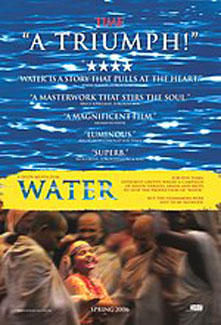 |
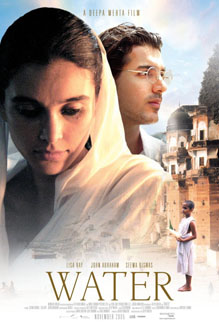 |
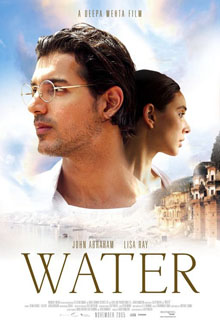 |
Theatrical Release: September 8th, 2005 (Toronto International Film Festival)
Reviews More Reviews DVD Reviews
DVD Review: 20th Century Fox - Region 1 - NTSC
Big thanks to Kurtis Beard for the Review!
| DVD Box Cover |
|
CLICK to order from: |
| Distribution |
20th Century Fox Region 1 - NTSC |
|
| Runtime | 1:57:12 | |
| Video |
2.34:1 Original Aspect Ratio
16X9 enhanced |
|
|
NOTE: The Vertical axis represents the bits transferred per second. The Horizontal is the time in minutes. |
||
| Bitrate |
|
|
| Audio | Dolby Digital 5.1 (Hindi) | |
| Subtitles | English, Spanish, none | |
| Features |
Release Information: Studio: 20th Century Fox Aspect Ratio:
Edition Details: Chapters 24 |
|
| Comments |
Video: “Water” is presented in the original aspect ratio of 2.35:1. Colors are crisp and purposely tinted in hues of green and blue throughout the film. Shadows and darkness are contrasted impeccably in this impressive transfer from Fox. I didn’t notice any instances of damage (no scratches, blemishes nor dirt). Another DVD is available from Mongrel Media, but having never seen the transfer, I cannot comment on its quality compared to Fox’s work here. Regardless, you’d be hard pressed to find an improvement on this pristine image. Audio: Audio is presented in the form of a crisp Hindi Dolby Digital 5.1 track. Sound effects are well contrasted with the beautifully rendered musical compositions from Mychael Danna. I prefer the crisp white subtitles found here over the ugly yellow ones often used elsewhere. I’ve heard complaints over the size of the subtitles, but I had no such problem. Again, Mongrel Media’s DVD may be of interest here. In their 2-Disc Special Edition, they’ve provided an alternative version of the film that was shot at the same time by Deepa Mehta in English by the same cast. I could see this version interesting viewers who would prefer to avoid subtitles and dubbing, but personally, I always favor audio tracks in native languages for their more naturalistic feel. Mongrel Media’s DVD also has a DTS track so be advised that alternative and perhaps more enhanced audio tracks exist elsewhere. Extras: In an excellent director’s commentary, Deepa Mehta speaks fluently and succinctly about the topic of her film and a number of other aspects about production. The information Metha offers about religion is especially insightful and I walked away with a great deal of knowledge that I may have never found elsewhere. This is a fine commentary and Mehta is a pleasure to listen to. The “Behind-the-Scenes” extra is a relatively good featurette, albeit some information is repeated from the commentary. Cast and crew interviews are interesting and I particularly enjoyed listening to the beautiful Lisa Ray speak about her experience and approach to the film. Mehta, again, offers a wealth of information about various stages of production. This extra also shows interaction between the director and cast/crew on set, which is rather valuable for fans of the film and Mehta. Finally, the “The Story Behind the Making of Water” featurette is brief and very much in the vein of EPK material. For those who are looking for insight into the film and production, stick to the other extras. Here, in the extras department, Fox’s DVD fails to match Mongrel Media’s release, which offers additional featurettes and interviews. But, given what Fox offers, this is still a fine DVD release. |
DVD Menus
|
|
|
|
|
|
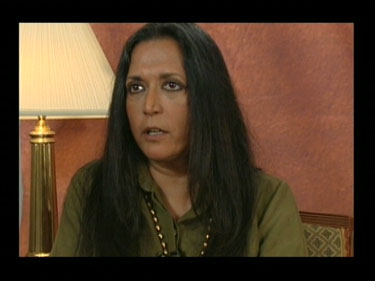 |
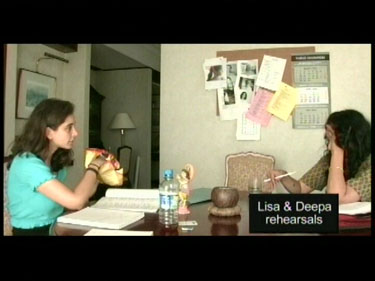 |
Screen Captures
Subtitle Sample
|
|
|
|
|
|
|
|
|
|
|
|
|
|


